On test: Ford Explorer offers speed and comfort – at a price
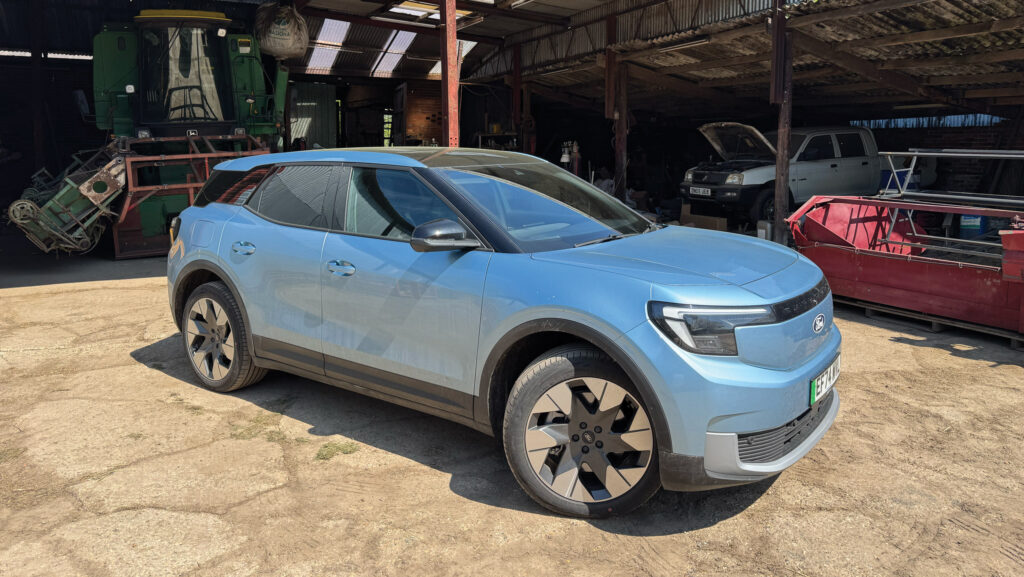 © MAG/Oliver Mark
© MAG/Oliver Mark Ford’s unlikely alliance with rival Volkswagen has spawned a series of electric SUVs, as it looks to replace some of its best-known nameplates – Fiesta, Focus, Mondeo, et al – with, erm, some others.
To add kudos to its electric offensive, it has reimagined the Mustang and Puma, brought back the Capri – albeit nothing like it was – and, late last year, launched the subject of this test: the Explorer.
See also: On test: Electric assistance for Toyota Hilux Hybrid 48V
While the latter’s US-built namesake is a petrol-slurping lump, the European-made version is fuelled by electrons, modestly proportioned and seriously rapid.
This compact SUV – identical to the Capri but without the coupe-ish boot – is less than a second slower than a Porsche Macan S and will carry five in the whisper-quiet serenity of a Thai yoga retreat.
And thanks to a big ol’ 79kWh battery, it’s still capable of breaking 250 miles non-stop on a steady run.
Fordwagen
Although Ford has had its say on how the Explorer looks and drives, its lineage can be traced back not to the US car of the same name, but to once arch-rival and now manufacturing buddy Volkswagen.
In a role reversal of the pickups, where the Amarok shares all but the interior and tinwork of the Ranger, this time the two automotive powerhouses use VW’s compact electric SUV platform, dubbed the MEB.
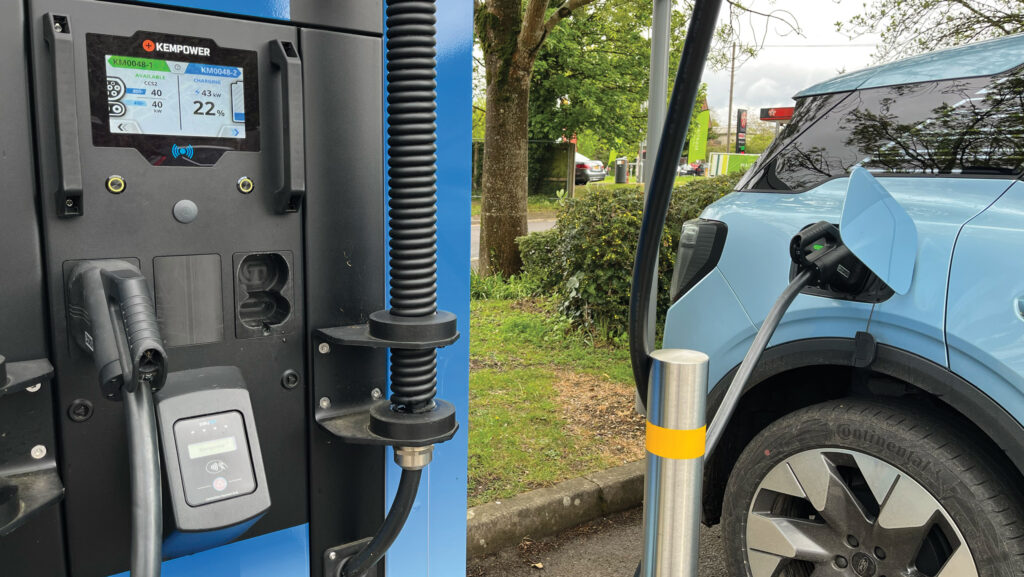
A fast charger will get the battery to 80% in 26mins © MAG/Oliver Mark
Peel back the skin and the Explorer is a replica of the ID.4, albeit put together in the Blue Oval’s factory in Cologne, Germany – once home to the late-of-this-parish Fiesta.
From Ford’s perspective, the deal has taken the sting out of development costs and fast-tracked its somewhat pedestrian pivot to electric vehicles.
But it has dedicated time and cash to designing the shell and interior, and fettling the suspension and driving characteristics to its liking.
As a result, the two vehicles look very different: the Explorer shorter than an ID.4 and fronted by a blunt, pug-like nose.
Behind comes a heavily raked windscreen, shallow side windows and curvy bodywork, which give the sort of squat, aerodynamic profile reminiscent of a Range Rover Evoque – albeit slightly lower key.
How quick?
As mentioned, the flagship Explorer Premium all-wheel drive model featured here is rapid.
As the only 4×4 derivative, it gets a pokier 340hp/679Nm twin motor setup that will whip it up to 62mph in 5.3sec. It’s never wanting for traction either, even on relatively loose surfaces.
This lightning rate of acceleration and sharp handling, combined with the silence, small rear windows and low seats, is enough to risk nauseated back-seat kids soiling the furniture.
Fortunately, that initial frenzy gradually dissipates into a more normal driving experience as the speed rises, and it can be avoided altogether thanks to a nicely weighted throttle.
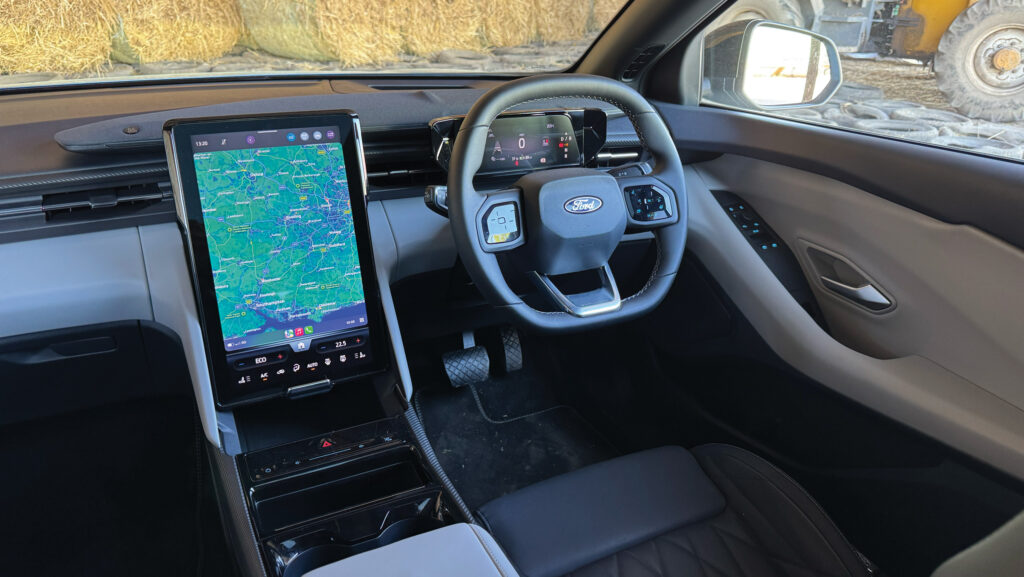
There’s a big touchscreen and plenty of storage space, but very few physical controls © MAG/Oliver Mark
There are several means of altering its performance, starting with the two modes – D and B – on the twist-to-select drivestick that juts out from the steering column.
The latter harvests more energy to regenerate the batteries as the throttle is released, to such a degree that the slightly spongy brake pedal is seldom required.
There are other settings too – “traction” to optimise torque distribution and improve grip on challenging surfaces, and “eco”, which strangles the air conditioning and delivers tempered, passenger-friendly acceleration to extend battery life.
How far will it go?
The Premium AWD has a combined cycle range of 329 miles, though this drops to 255 for long motorway schleps. We found the latter a more realistic figure for a mixed driving route.
As for replenishing the cells, a 185kW fast charger – if you can find one – will take it from 10-80% in 26mins, with the remaining 20% trickled in.
Any cheaper models?
As the name suggests, the Premium AWD is the priciest variant, at £53,985.
The rest of the range – all rear-wheel drive – is divvied up according to powertrain and trim level.
One peg down are the “extended range” models, geared up with a 77kWh battery pack – a whisker smaller than the AWD – and a 286hp/545Nm motor.
They are slightly slower than the AWD – 62mph comes in a respectable 6.4sec – but have a better range, of 354 miles in Premium guise (£49,985) and an impressive 374 in the case of the sole mid-spec model, the Select.
And those content with modest performance levels can carve up to £15k off the cost with one of two “standard” versions.
These pack a 52kWh battery and 170hp/310Nm motor; the Premium (£43,985) rated to 221 miles and basic Style spec (£39,285) to 233.
What about the interior?
As is the modern-day way, a 14.6in portrait-oriented touchscreen dominates the room.
Unusually, this can be slid up and down, from a near-vertical position high on the dash to cocked at a low, 45deg angle. This helps eliminate glare and conceals or reveals a secret cubby behind.
The smartphone-style software is relatively easy to navigate, and the graphics satisfyingly razor-sharp.
Climate controls are permanently fixed at the bottom – forcing eyes to wander a long way from the road – though a head-up display in the windscreen at least puts speed and limit in the driver’s line of sight.
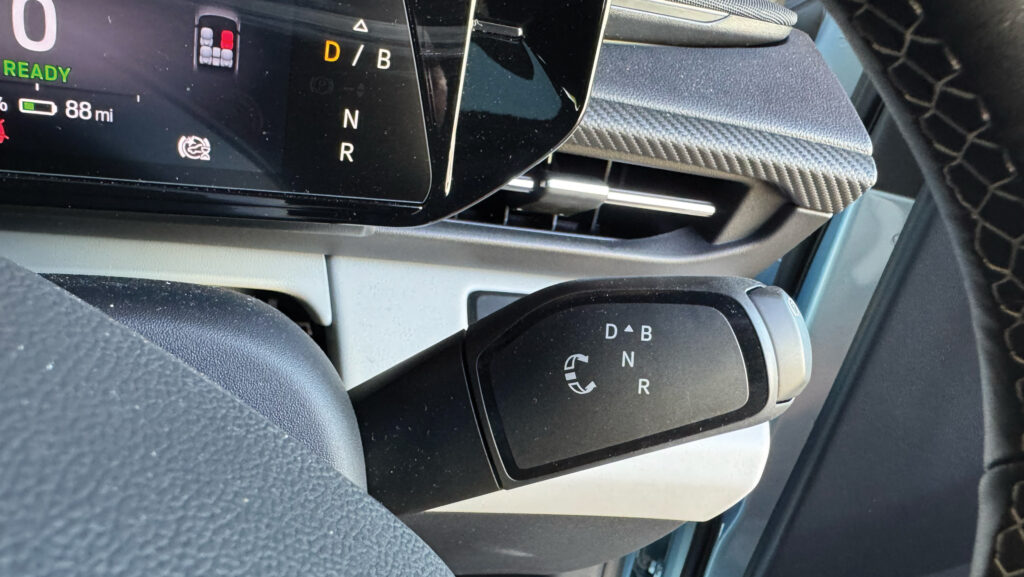
Column-mounted drivestick keeps the centre console clutter-free © MAG/ Oliver Mark
Beyond that, the Explorer feels kind of empty. Next to no buttons, no central gear selector, no handbrake. Even the four windows are opened and closed via two switches, with a toggle between them.
The big downside here is the loathsome VW-sourced haptic sliders, most of which are splattered over the quirky, oblong-ish steering wheel.
Fortunately, an attractive mix of textured materials avoids it feeling entirely barren, the most notable fixture being a surfboard shaped sound bar across the top of the dash. It looks smart but is probably a nightmare to dust.
To keep things as minimalist and tidy as Ford’s OCD designers presumably imagined, there are enough tucked-away stash spots to satisfy a professional drug runner.
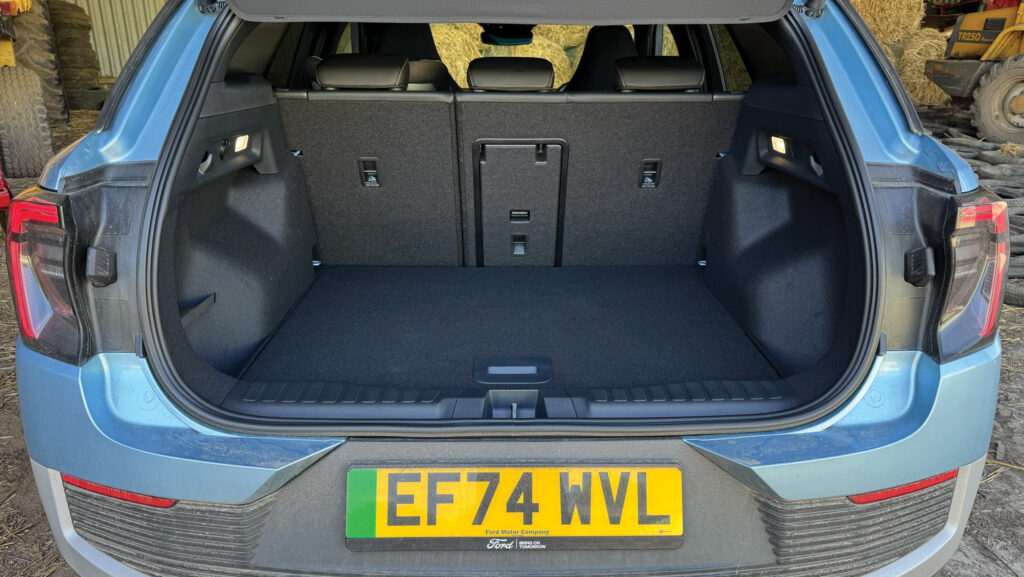
Short rear overhang makes for a relatively small boot © MAG/Oliver Mark
As well as the one behind the touchscreen, there’s a Tardis-like MegaConsole between the front seats that, at 17 litres, will swallow a laptop, handbag or small dog.
And occupants should have no qualms about the comfort levels.
The legs and heads of gangly teenagers in the back are well accounted for – helped by the lack of a transmission tunnel – and, on the Premium, they are bathed in light through a panoramic glass roof.
Though the seat bases are relatively short, there’s ample cushioning on the padded, quilted leather, and the rear ones fold near flat to vastly increase the size of the modestly proportioned boot.
Farmers Weekly verdict
It’s hard to know where to start with electric vehicles these days, particularly when it comes to small SUVs. The country is crawling with choice.
But the AWD Explorer is a sound bet – fast, smooth, comfortable and, though not necessarily the thing to deliver rousing tales of off-road prowess, perfectly competent on the slippery grass and farm tracks it’s most likely to encounter.
Likes and gripes
Likes
- Seriously quick
- Decent range
- Sharp handling
- Stacks of storage
Gripes
- Naff haptic buttons
- Unremarkable visibility
- Small-ish boot
Ford Explorer Premium AWD specs
- Drive Twin electric motors
- Max power/torque 340hp/679Nm
- Top speed 112mph
- Battery 79kWh
- Combined range 323 miles
- Motorway range 257 miles
- Economy 3.74 miles/kWh
- Charge time (10-80%) 26 mins
- Kerb weight 2,209kg
- Ground clearance 202mm
- Towing capacity 1,400kg
- Price as tested £53,985

